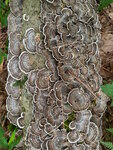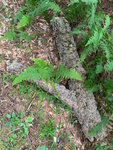Fungi are fascinating, not only for their ecological, medicinal and culinary properties, but also for the multitude of interesting forms in which they appear.
From puffballs to slime molds, from …
Stay informed about your community and support local independent journalism.
Subscribe to The River Reporter today. click here
This item is available in full to subscribers.
Please log in to continue |


Fungi are fascinating, not only for their ecological, medicinal and culinary properties, but also for the multitude of interesting forms in which they appear.
From puffballs to slime molds, from boletes to bracket fungi, mushrooms capture the imagination and inspire a desire to learn about these fetching fellow inhabitants of our Northeast forests.
One of the most photogenic bracket fungi (also referred to as shelf fungi for their resemblance to shelves as they grow from the sides of trees) is the turkey tail (Trametes versicolor), which does indeed resemble the tail of a wild turkey. Viewed from above, its subtle but multi-colored concentric crescents range from earthy browns and tans to smoky grays and umber striping with white or light coloration at the margins, as depicted in the photo here. For more photos, visit River Talk at www.riverreporter.com
When fresh, turkey tail is white on the underside and features fine, barely discernible pores that differentiate it from false turkey tail, which displays a creamier tan or brownish underside without pores and has a flat appearance.
Weather conditions in the Upper Delaware River region lately have contributed to a great abundance of mushrooms appearing in our forested landscapes. As with all mushrooms, some are edible; many are not. Never consume one without positive identification. You might find yourself fighting for your life—or worse.
Fortunately, there are many excellent resources available to guide one’s forays into the world of fungi, such as Gary Lincoff’s “National Audubon Society Field Guide to North American Mushrooms.” Fungi fans will also enjoy “Mycophilia: Revelations from the Weird World of Mushrooms” by food writer Eugenia Bone, former president of the New York Mycological Society.
For a terrific online resource, visit the website of Adam Haritan, founder of Learn Your Land (learnyourland.com/about/). There you can access nearly 200 free videos related to the natural world. At the following link, learn how to distinguish between turkey tail and two of its look-alikes, learnyourland.com/turkey-tail-mushroom-trametes-versicolor-its-look-alikes-medicinal-benefits/ as well as the intriguing health benefits this mushroom offers.
“Turkey tail is a premiere medicinal mushroom,” writes Haritan. “Used traditionally for centuries in Asian cultures, this species is currently one of the most well-researched fungi in the areas of cancer, immune system recovery and human health. Numerous medicinal compounds have been isolated from turkey tail, and several clinical trials have been performed on human participants.”
A self-described “nature enthusiast, observer, documenter and faithful adherent to the land in western Pennsylvania,” Haritan leads classes and workshops related to plant and mushroom identification, wild food harvesting, nutritional and medicinal components of wild foods, and the benefits of connecting with nature.
The knowledgeable and dedicated Haritan has also created online courses in mushroom foraging and tree identification to encourage active participation and engagement with one’s local ecology. Learn more at courses.learnyourland.com/.
Comments
No comments on this item Please log in to comment by clicking here